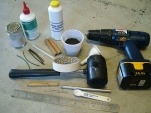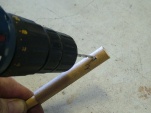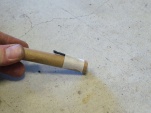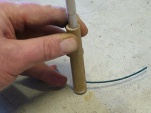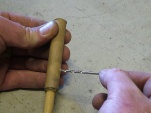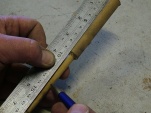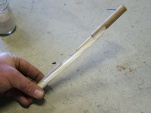Saxon
From PyroGuide
The saxon is a rapidly spinning ground based firework that is basic in design and construction. There are slight variations but typically it consists of two tubes which are filled with composition and have a clay plug at the end. They are joined in the centre by wooden dowel and pivot at point in the middle. It is driven by exhaust or vents located on the sides of the tube near the end plugs which are at right angles to the tube axis. Depending on the pyrotechnic compositions used, the saxons effect can range from tight, compact circles of delicate, lacey orange sparks to huge, brilliant silver and white displays twenty feet or more in diameter. The saxon is normally mounted on a post or structure about 10 foot from the ground.
[edit] MaterialsCasing Tools Propellant
Any fountain or gerb formula will work well in saxons. You can even use colour driver compositions. | ||||||||||||||||||||||||||
[edit] ConstructionIdentify each tube by marking them with the number 1 and 2. Temporarily seal one end of each casing with a bit of paper tape and take a small amount of nozzle mix and dump this into the casing, tapping it to settle the powder. The aim is to approximately make the end plug the same thickness of the casings inner diameter. | ||||||||||||||||||||||||||
|
A nozzle hole now needs to be drilled in each tube as close to the clay plug as possible. Using a 3mm drill bit, drill a hole into the side of the tube. To drill a cleaner hole insert a length of wooden dowel all the way to the end plug so the drill bit will actually drill into the wood. Pre-drilling these holes prior to pressing the composition allows you greater control to position the nozzle hole as close to the clay plug as possible. Also it is safer practice as drilling into composition causes friction and may result in accidental ignition. There are ways in which the nozzle hole can be reinforced to prevent it burning into a large hole. One quick solution to this is using waterglass. However as this device spins so easily and freely it is generally not required as it will still function very well even after the nozzle hole has expanded. | ||||||||||||||||||||||||||
|
Drill another 3mm relay hole into tube number one about 3/4 up from the plugged end on the opposite side from the nozzle exhaust. Place a small piece of paper masking tape over the relay hole. | ||||||||||||||||||||||||||
|
In tube 2 insert a 5cm length of black match into the nozzle so that approximately 3/4 of the black match remains outside of the hole. If you find the black match is too thin, then you can insert two pieces so that it completely fills the nozzle hole. Bend the black match down so that it lies parallel with the axis of the tube and tape it in place. The tape needs to cover the nozzle hole and the black match. In tube one insert a good length of visco fuse into the nozzle hole, this will be what you will ignite to start the saxon. | ||||||||||||||||||||||||||
|
If you have prepared two different formulas then press the silver titanium composition into tube 1 and the gold glitter composition into tube 2 and leave approximately 2 cm empty in each tube. Ensure the composition has been filled passed the 3mm relay hole that was drilled in tube 1 with the pressed composition. | ||||||||||||||||||||||||||
|
Now the tubes need to be attached to the wooden dowel, and this can be done with either white glue or a hot glue gun. Start by attaching tube number 1. Place glue on the wooden dowel and quickly slide it into tube 1. Clean up any excess glue with an old rag. With tube number 2 we need to align the nozzle holes so that they are pointing in opposite directions. Do this by inserting the dowel into tube 2, align the holes and mark a reference point with pencil. Now permanently attach tube 2 to the dowel using your glue making sure you realign the reference mark. Allow the glue to dry completely. | ||||||||||||||||||||||||||
|
Hand drill a small hole into the composition through the relay hole in tube 1. Do this slowly to prevent any friction and use the same 3mm drill bit you used to create the hole. Insert a 5cm length of black match and bend the black match down towards the nozzle hole in tube 2 so that it lies parallel with the axis of the tube and tape it in place. The tape needs to cover the relay hole and the black match. | ||||||||||||||||||||||||||
|
Using a ruler measure the length of the assembled device. Divide this number by 2 to find the midpoint. Using a pencil mark a reference for the midpoint and drill a 3mm hole (or a hole slightly larger than the thickness of the nail we will be using later) as this is will be the pivot point for the spinning device. | ||||||||||||||||||||||||||
|
Attach a length of paper tape quick match from the relay hole on tube 1 to the nozzle hole in tube 2 (both the relay hole and the nozzle hole on tube 2 should be on the same side of the saxon). Do this by sliding the sleeve of the paper tape quick match over the black match. Make sure there is powder in the relay hole to ensure ignition of the black match, you will need to remove the paper tape. Once the paper tape quick match has been attached, secure it to the saxon device with some paper tape. | ||||||||||||||||||||||||||
|
Insert a nail into the pivot hole of the saxon, it should be a loose fit and the wooden dowel needs to spin without any resistance. A spacer needs to be placed between the post and the wooden dowel and this can be in the form of a small plastic tube. This will make sure the saxon will spin freely during effect time and not come into contact with the block of wood. Take care when nailing the saxon to the block of wood as potentially a spark may cause accidental ignition. The saxon should be mounted at least 6 feet off the ground, the higher the better. The block of wood can now be nailed or screwed in place ready for use. | ||||||||||||||||||||||||||
[edit] Video
Saxon 1.3meg - Saxon which is driven with RP propellant. It worked great but the effect would have been better if gold glitter or silver titanium had been used.
Saxon 1.2meg - Another saxon driven with RP propellant which is more effective than the above example. This video just shows the first half of the saxon display.
